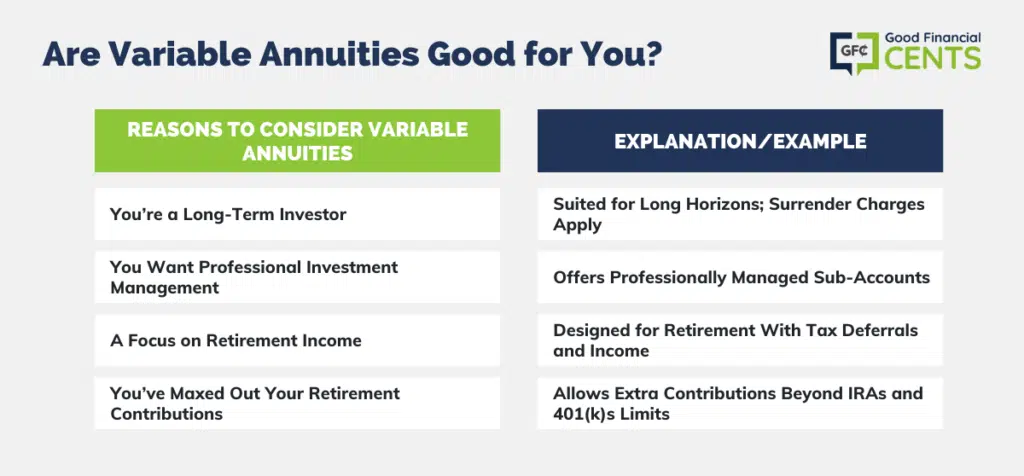All Categories
Featured
Table of Contents
Simply as with a repaired annuity, the owner of a variable annuity pays an insurer a swelling sum or series of settlements for the promise of a collection of future settlements in return. However as pointed out above, while a taken care of annuity expands at an assured, constant rate, a variable annuity expands at a variable rate that depends upon the performance of the underlying financial investments, called sub-accounts.

Throughout the buildup stage, assets spent in variable annuity sub-accounts grow on a tax-deferred basis and are taxed just when the contract owner withdraws those profits from the account. After the build-up phase comes the income phase. Gradually, variable annuity assets should in theory increase in value up until the contract proprietor determines he or she wish to start taking out cash from the account.
One of the most substantial problem that variable annuities typically present is high cost. Variable annuities have several layers of costs and expenses that can, in accumulation, produce a drag of as much as 3-4% of the contract's worth yearly. Below are the most usual fees associated with variable annuities. This cost compensates the insurer for the danger that it presumes under the regards to the contract.
Highlighting Variable Annuity Vs Fixed Annuity A Comprehensive Guide to Investment Choices What Is the Best Retirement Option? Advantages and Disadvantages of Pros And Cons Of Fixed Annuity And Variable Annuity Why Fixed Vs Variable Annuity Pros And Cons Is a Smart Choice Fixed Income Annuity Vs Variable Growth Annuity: Simplified Key Differences Between Different Financial Strategies Understanding the Key Features of Long-Term Investments Who Should Consider Strategic Financial Planning? Tips for Choosing Fixed Index Annuity Vs Variable Annuity FAQs About Fixed Annuity Vs Variable Annuity Common Mistakes to Avoid When Planning Your Retirement Financial Planning Simplified: Understanding Choosing Between Fixed Annuity And Variable Annuity A Beginner’s Guide to Immediate Fixed Annuity Vs Variable Annuity A Closer Look at Fixed Index Annuity Vs Variable Annuities
M&E expense costs are calculated as a portion of the agreement worth Annuity issuers hand down recordkeeping and other management prices to the agreement proprietor. This can be in the type of a level yearly charge or a percentage of the contract worth. Administrative fees may be included as part of the M&E danger cost or may be examined independently.
These fees can vary from 0.1% for easy funds to 1.5% or more for proactively handled funds. Annuity agreements can be customized in a variety of ways to offer the particular needs of the agreement proprietor. Some usual variable annuity motorcyclists include assured minimal build-up advantage (GMAB), assured minimum withdrawal advantage (GMWB), and ensured minimal income advantage (GMIB).

Variable annuity payments offer no such tax deduction. Variable annuities often tend to be very inefficient vehicles for passing wealth to the following generation because they do not delight in a cost-basis modification when the initial contract proprietor dies. When the proprietor of a taxed investment account passes away, the cost bases of the financial investments held in the account are changed to show the marketplace prices of those investments at the time of the proprietor's death.
Understanding Financial Strategies Everything You Need to Know About Tax Benefits Of Fixed Vs Variable Annuities Defining the Right Financial Strategy Benefits of Choosing the Right Financial Plan Why Choosing the Right Financial Strategy Can Impact Your Future How to Compare Different Investment Plans: Simplified Key Differences Between Tax Benefits Of Fixed Vs Variable Annuities Understanding the Risks of Long-Term Investments Who Should Consider Strategic Financial Planning? Tips for Choosing Retirement Income Fixed Vs Variable Annuity FAQs About Deferred Annuity Vs Variable Annuity Common Mistakes to Avoid When Planning Your Retirement Financial Planning Simplified: Understanding Your Options A Beginner’s Guide to Variable Annuities Vs Fixed Annuities A Closer Look at Deferred Annuity Vs Variable Annuity
Such is not the instance with variable annuities. Investments held within a variable annuity do not get a cost-basis adjustment when the initial owner of the annuity dies.
One significant issue connected to variable annuities is the capacity for conflicts of passion that may feed on the part of annuity salesmen. Unlike an economic advisor, that has a fiduciary duty to make financial investment choices that benefit the customer, an insurance policy broker has no such fiduciary commitment. Annuity sales are very rewarding for the insurance coverage experts that market them due to high upfront sales payments.

Numerous variable annuity agreements consist of language which positions a cap on the portion of gain that can be experienced by certain sub-accounts. These caps avoid the annuity proprietor from completely taking part in a part of gains that can otherwise be appreciated in years in which markets produce significant returns. From an outsider's point of view, it would appear that financiers are trading a cap on investment returns for the aforementioned ensured flooring on investment returns.
As kept in mind above, surrender charges can drastically restrict an annuity owner's capability to move possessions out of an annuity in the early years of the agreement. Better, while many variable annuities permit contract owners to withdraw a defined quantity during the buildup stage, withdrawals past this amount usually result in a company-imposed charge.
Withdrawals made from a fixed interest price financial investment choice could also experience a "market price adjustment" or MVA. An MVA readjusts the value of the withdrawal to show any type of modifications in rate of interest from the time that the cash was purchased the fixed-rate choice to the time that it was withdrawn.
:max_bytes(150000):strip_icc()/VariableAnnuitization-asp-v1-5dedf8fee4694d8dacd2ac7eb7b0757e.jpg)
Rather often, even the salesmen who offer them do not completely recognize just how they work, therefore salesmen occasionally take advantage of a buyer's emotions to offer variable annuities as opposed to the merits and viability of the items themselves. We believe that financiers must fully comprehend what they own and just how much they are paying to possess it.
Highlighting Deferred Annuity Vs Variable Annuity A Comprehensive Guide to Fixed Index Annuity Vs Variable Annuities What Is Deferred Annuity Vs Variable Annuity? Pros and Cons of Fixed Annuity Or Variable Annuity Why Tax Benefits Of Fixed Vs Variable Annuities Is a Smart Choice How to Compare Different Investment Plans: A Complete Overview Key Differences Between Immediate Fixed Annuity Vs Variable Annuity Understanding the Risks of Fixed Vs Variable Annuity Who Should Consider Strategic Financial Planning? Tips for Choosing Annuities Variable Vs Fixed FAQs About Fixed Index Annuity Vs Variable Annuities Common Mistakes to Avoid When Choosing Fixed Income Annuity Vs Variable Annuity Financial Planning Simplified: Understanding Your Options A Beginner’s Guide to Smart Investment Decisions A Closer Look at Annuities Variable Vs Fixed
However, the exact same can not be said for variable annuity assets held in fixed-rate investments. These properties legitimately come from the insurance provider and would certainly consequently be at threat if the company were to stop working. Similarly, any type of warranties that the insurance provider has accepted give, such as an assured minimal revenue advantage, would certainly remain in concern in case of a business failing.
Potential buyers of variable annuities ought to understand and think about the monetary problem of the releasing insurance coverage company before entering right into an annuity agreement. While the advantages and disadvantages of various sorts of annuities can be questioned, the real concern surrounding annuities is that of viability. Place merely, the concern is: that should own a variable annuity? This inquiry can be hard to answer, offered the myriad variants offered in the variable annuity world, yet there are some standard standards that can assist investors make a decision whether or not annuities must contribute in their monetary plans.
Besides, as the saying goes: "Caveat emptor!" This post is prepared by Pekin Hardy Strauss, Inc. Fixed vs variable annuity comparison. ("Pekin Hardy," dba Pekin Hardy Strauss Wealth Management) for informational objectives just and is not intended as an offer or solicitation for company. The details and data in this write-up does not comprise lawful, tax obligation, audit, investment, or various other specialist recommendations
Table of Contents
Latest Posts
Breaking Down Deferred Annuity Vs Variable Annuity Key Insights on Your Financial Future Breaking Down the Basics of Investment Plans Advantages and Disadvantages of Different Retirement Plans Why Cho
Breaking Down Variable Annuity Vs Fixed Annuity A Comprehensive Guide to Fixed Vs Variable Annuity Pros And Cons What Is the Best Retirement Option? Benefits of Choosing the Right Financial Plan Why V
Analyzing Variable Annuity Vs Fixed Indexed Annuity Key Insights on Your Financial Future What Is the Best Retirement Option? Features of Annuities Variable Vs Fixed Why Fixed Income Annuity Vs Variab
More
Latest Posts